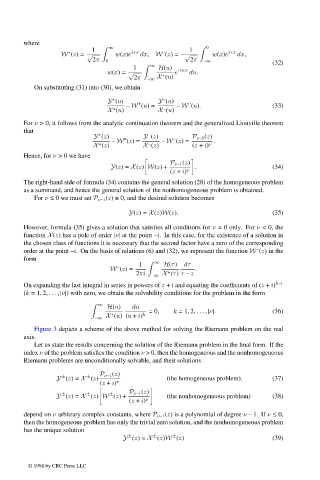Page 521 - Handbook Of Integral Equations
P. 521
where
0
1 ∞ 1
+ izx – izx
W (z)= √ w(x)e dx, W (z)= – √ w(x)e dx,
2π 0 2π –∞
(32)
1 ∞ H(u) –iux
w(x)= √ + e du.
2π –∞ X (u)
On substituting (31) into (30), we obtain
+
–
Y (u) + Y (u) –
– W (u)= – W (u). (33)
–
+
X (u) X (u)
For ν > 0, it follows from the analytic continuation theorem and the generalized Liouville theorem
that
–
+
Y (z) + Y (z) – P ν–1 (z)
– W (z)= – W (z)= .
–
X (z) X (z) (z + i) ν
+
Hence, for ν > 0 we have
P ν–1 (z)
Y(z)= X(z) W(z)+ . (34)
(z + i) ν
The right-hand side of formula (34) contains the general solution (28) of the homogeneous problem
as a summand, and hence the general solution of the nonhomogeneous problem is obtained.
For ν ≤ 0 we must set P ν–1 (z) ≡ 0, and the desired solution becomes
Y(z)= X(z)W(z). (35)
However, formula (35) gives a solution that satisfies all conditions for ν = 0 only. For ν < 0, the
function X(z) has a pole of order |ν| at the point –i. In this case, for the existence of a solution in
the chosen class of functions it is necessary that the second factor have a zero of the corresponding
–
order at the point –i. On the basis of relations (6) and (32), we represent the function W (z) in the
form
1 ∞ H(τ) dτ
–
W (z)= .
+
2πi X (τ) τ – z
–∞
On expanding the last integral in series in powers of z + i and equating the coefficients of (z + i) k–1
(k =1, 2, ... , |ν|) with zero, we obtain the solvability conditions for the problem in the form
∞
H(u) du
=0, k =1, 2, ... , |ν|. (36)
+
X (u) (u + i) k
–∞
Figure 3 depicts a scheme of the above method for solving the Riemann problem on the real
axis.
Let us state the results concerning the solution of the Riemann problem in the final form. If the
index ν of the problem satisfies the condition ν > 0, then the homogeneous and the nonhomogeneous
Riemann problems are unconditionally solvable, and their solutions
P ν–1 (z)
±
±
Y (z)= X (z) (the homogeneous problem), (37)
(z + i) ν
P ν–1 (z)
±
±
±
Y (z)= X (z) W (z)+ (the nonhomogeneous problem) (38)
(z + i) ν
depend on ν arbitrary complex constants, where P ν–1 (z) is a polynomial of degree ν – 1. If ν ≤ 0,
then the homogeneous problem has only the trivial zero solution, and the nonhomogeneous problem
has the unique solution
±
±
±
Y (z)= X (z)W (z) (39)
© 1998 by CRC Press LLC
© 1998 by CRC Press LLC
Page 503

